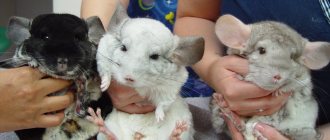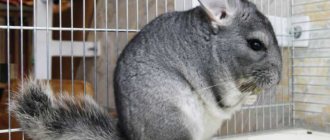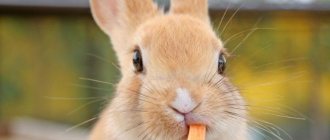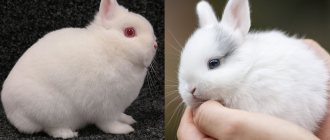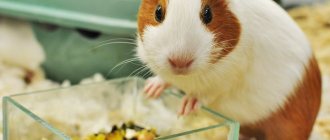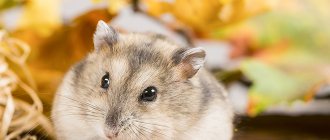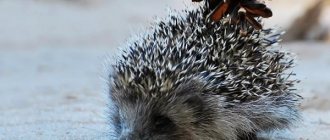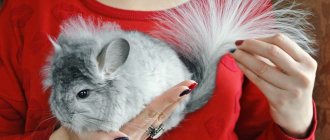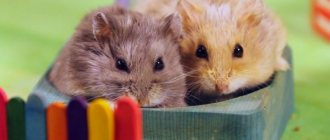General signs of dwarf decorative rabbits
Decorative (dwarf) rabbits are animals weighing in the range of 1.5-2.5 kg, differing in the shape of the head and body, the length of the ears and the thickness of the coat.
Regardless of the breed, miniature animals vary in hair length.
| Type of rabbits | Hair length in cm |
| Shorthair | 1,50 – 2,0 |
| Normal hair | 2,50 – 4,0 |
| Downy (long-haired) | Over 5.0 |
Dwarf rabbits vary in fur length and ear shape
The coat of dwarf rabbits is soft and silky. The body of representatives of this class of rodents is characteristic of all rabbits - rounded, shortened in length. The head looks quite massive, its ratio with the length of the body is 1:2, the neck is practically absent. The ears of miniature rodents can be very short - up to 5-6 cm, or hang below the level of the lower jaw and reach a length of 20 cm.
Breeders are developing varieties of mini-rabbits of various colors
The purpose of dwarf rabbits is different from domestic rodents for meat or fur-and-down production. Their goal is to please their owners with their appearance, affectionate nature and playfulness. The majority of dwarf rabbit breeds are bred for keeping in a home or apartment.
Popular breeds
Let's look at the most popular breeds of decorative rabbits for home raising:
- Lop-eared dwarf Ram - he looks spontaneous and funny due to the original shape of his ears, which seem to form a horseshoe.
How long do dwarf rams live and how to care for them?
article.
- Colored dwarfs - available in a wide variety of colors; they are cute and easy-to-care animals.
- Dwarf foxes have long, very pleasant to the touch fur. The fur color can be white, red or blue.
- Dwarf Angoras have luxurious fur and are especially popular with young children.
Angora dwarf rabbit
- Rex - wide range of colors, plush fur, very pleasant to the touch. An ideal breed for small children.
- Japanese dwarf - can be two-colored.
- Hermelines are white dwarf rodents with red or blue eyes. The fur is short and thick.
Dwarf rabbit Hermelin
Before choosing, be sure to carefully read the characteristics of the breed and consult with the breeder. The fact is that each type of decorative rabbit has its own character, the features of which are best known in advance.
Some breeds like Hermelins are quite aggressive, so they are not worth buying for children.
Why is the dwarf rabbit offended?
For any reason! I will list just a few reasons for resentment (but in fact there are many more):
* you took the rabbit for vaccination
* you put a harness on your pet and forced him to walk around in it (oh, horror!)
* you scolded a dwarf rabbit for some offense
* you trimmed the baby’s claws, washed him or, God forbid, installed a thermometer (you know where this thermometer is inserted)
* you brought another rabbit! (show this article to those who think that a dwarf rabbit needs a mate)
* you went on vacation and left the rabbit with someone else
So, what do you think of this introductory list?
It turns out that a dwarf rabbit can get offended for absolutely any reason! This does not mean that every pet will be offended by everything. Due to the characteristics and individuality of his character, he will choose what affects him. But in any case, you will experience unpleasant sensations.
First meeting
All you need to know about decorative rabbits is that they are quite shy. Therefore, when meeting for the first time, there is no need to immediately try to cuddle or stroke the animals. Like any other pet, babies need to get comfortable, get used to it, and adapt. If you suddenly rush at him with expressions of love, the rabbit will simply get scared and hide in a corner.
It would be better to carefully and slowly reach out to him and treat him with some goodies. It can be vegetables, fruits.
You need to talk to the rabbit in a gentle, quiet and calm voice - this way he will quickly understand that the new owner does not pose a danger to him.
Features of keeping rabbits in an apartment
The apartment must be carefully prepared for the arrival of a new resident: remove all unnecessary items from the floor, because rabbits are charming rodents and will want to taste everything they can get their hands on.
Particular attention must be paid to low-lying wires: they will have to be removed completely or hidden in cable channels. The rabbit will most likely also pay attention to wallpaper, shoes and other household items.
Rabbit cage
A place to keep a rabbit should be selected in accordance with your own preferences and capabilities. This could be a cage, house or enclosure. A cage-free option is also possible, because rabbits are very active and mobile animals.
- The cage for keeping rabbits must be selected especially carefully. It is unacceptable to use a plastic cage to keep rabbits.
- Its size should be such that the rabbit can freely stand on its hind legs and not rest against the ceiling.
- A rabbit is a burrowing animal, so it is advisable to darken the part of the cage in which the animal will rest.
- This will ensure a restful sleep and also serve as a place to hide if the rabbit needs privacy.
- A separate part of the cage should be set up as a place for eating. A feeding trough, hay barn and drinking bowl are conveniently located here. The shape of the cell is not particularly important.
- Rabbits do not like drafts, this must be taken into account when choosing a place for it.
Feeder
Particular attention must be paid to the choice of feeder. You should not buy plastic utensils, they will become unusable very quickly. It is better to give preference to a heavy ceramic feeder. This option will avoid tipping over and the food will not end up under the rabbit’s feet. The feeder and drinker can also be hung from the bars of the cage or enclosure.
Cleaning the cage
The cage requires daily attention.
It’s not difficult and won’t take much time, you just need to:
- Replace old food and hay.
- Wash the drinking bowl and fill it with clean water.
- Replace bedding or litter.
At least once a week it is necessary to carry out general cleaning in the cage: more thoroughly wash and disinfect the dishes and the room. For disinfection, you should not use solutions that contain strong chemicals; they can easily get into the rabbit’s stomach or burn its mouth.
Feeding a decorative rabbit
All food necessary for the excellent well-being of a decorative rabbit can be divided into several categories:
- concentrated - cereals, legumes, bran, mixed feed;
- coarse - twig food and hay;
- animal feed – milk, various dairy products, fish oil;
- juicy - carrots, cabbage, green salad, cucumbers;
- mineral - bone meal, salt, chalk.
It is not recommended to feed rabbits with exotic vegetables and fruits (tangerines, bananas, etc.), green potatoes, beets, and dill. Young peas and beans can cause bloating. Yeast bread, cheese, seeds and various sweets should also not be given to rabbits.
Feeding standards for each rabbit are individual. Every day, observing how much the rabbit eats, whether there is food left in the feeder or there is nothing in it for the next feeding, it is necessary to increase or decrease the portion for the pet.
Rabbit fur care
A decorative rabbit must be combed twice a week. For this, a special brush or furminator is usually used. During the molting period, the down of rabbits must be monitored especially carefully. The combing procedure should bring pleasure not only to the pet, but also to its owner.
To avoid tangles and tangles in long-haired animals, you can use various hair care products and sprays. After such procedures, the fur of a decorative rabbit becomes beautiful, smooth and shiny.
Nail care
Unfortunately, living in an apartment is unnatural for a rabbit, so from time to time it becomes necessary to cut your pet’s nails.
Of course, in this situation it is preferable to trust a specialist and take your rabbit to the veterinarian. But you can learn to perform these procedures at home.
Queen cell
A pregnant rabbit needs a special room, a queen cell, to give birth and hide newborn rabbits from prying eyes. Usually this is a small extension to a cage measuring 40x40x30 cm, into which a round hole leads. The queen cell looks like a hole. But the roof still needs to be made removable in order to control the behavior of the young mother, remove stillborn babies, and see if everyone has enough milk. A few days before giving birth, the female rabbit lines the bottom of the queen cell with her down. No assistance required during childbirth. She will also take care of the newborn rabbits herself. You just need to provide her with enough quality food and fresh drinking water. If the mother feels a lack of one or the other, she may eat her offspring.
Caring for a cat after castration in the first hours
After castration, a cat needs special care. Most veterinary clinics provide post-operative hospital services. In a special box with optimal climatic conditions, the operated pet is observed until it completely recovers from anesthesia. Once convinced that the cat’s condition is satisfactory, it is handed over to its owners.
Care in the first hours after castration comes down to monitoring your pets
If such a service is not available in the clinic or castration is performed at home, it is important to follow the following care recommendations:
To transport a cat after castration, it is recommended to use a loose carrier with a folding top and an absorbent diaper on the bottom. It is forbidden to transport an operated pet in your arms or in a car seat, as when waking up from anesthesia, it can harm itself or its owner. During transportation and further postoperative stay, the cat is placed on its side; It is recommended to lay an anesthetized, operated cat on the floor, since when it comes to its senses, it may fall off the table/sofa/bed. A common symptom of anesthesia sleep is uncontrollable urination. Using an absorbent diaper placed on the floor under the pet will make it much easier to eliminate such a nuisance; During anesthetized sleep, body temperature drops by 1-1.5°, so to prevent hypothermia, the operated pet is placed next to a heating radiator. It is strictly forbidden to place animals near electrical appliances with an open heating element. Instead of a battery, you can use a heating pad or a plastic bottle with hot, but not boiling water, which is placed next to the cat under a bedding or blanket
It is important that the heat does not come into contact with the cat's perineum, as this will cause bleeding. During the warm season, no additional warming procedure is required; for a more comfortable awakening from anesthesia sleep, it is recommended to close the curtains on the windows, since bright sunlight causes irritation of the optic nerve; Anesthesia sleep lasts from 15 to 120 minutes. depending on the method of administration and dose of the drug
During this time, it is necessary to monitor the cat so that it does not bury its nose in anything and suffocate. In addition, cats in this condition do not blink, which can cause the cornea to dry out. It is recommended to drip sterile saline solution, contact lens liquid, or eye drops without antibiotics into the eyes several times;
A protective collar will prevent your pet from licking the wound, further irritating it.
- Often waking up after anesthesia causes aggression in the pet. Therefore, it is recommended to provide the cat with complete rest for 24 hours, limiting access to him by other animals or children. It is forbidden to forcefully wake up your pet. Depending on the individual characteristics, after waking up, the cat may experience an unsteady gait, vomiting, involuntary urination, and a lethargic and drowsy state. This condition can last up to 8 hours, which is normal and should not cause concern;
- the wound on the scrotum after castration is not sutured, so it is recommended to minimize the amount of filler in the tray or replace it with absorbent paper. This will prevent the ingress of small filler particles and subsequent complications;
- A few hours after surgery, there may be slight bleeding from the incision, which is normal and safe for the cat. You can lightly dry the wound with a gauze cloth. In case of significant bleeding of more than 1 ml, you should urgently contact the doctor who performed the operation;
- Medicines prescribed by a veterinarian will help relieve pain. You can tell that a cat needs pain medication by dilated pupils, meowing, pursed paws, and aggression when attempting contact;
- You can prevent the possibility of damage to the healing incision by the cat’s rough tongue during hygiene by wearing a protective collar around the neck for several days. Such a product will limit the cat’s access to the wound without affecting food intake in any way.
Note! Veterinarians recommend castration in the fall or winter months, as during this period the likelihood of infection of the incision during rehabilitation is lower. In the summer, as a preventive measure for infection, the doctor prescribes a 5-day course of antibiotic treatment.
Is it possible to grab it by the withers?
If you look at the photo below, you will see that it is also not recommended to take an animal by a fold of skin on the neck or back. This is not as dangerous as in the case of the ears, but there are other, safer ways.
The fact that this method is more comfortable for the animal is evidenced by the fact that, as a rule, in this situation it does not break out or scratch. Most often, the crawl simply hangs down, while its neck and head are pulled back somewhat.If you use this method of lifting, then you must support the crawl’s body in the sacrum area with your second hand.
By the way, it is by the withers that the rabbits are carried by their parents. Some rabbit breeders advise holding animals with both hands at the same time: one in the neck area, the other in the back area. This way it will be in a horizontal position, and the body weight will be evenly distributed.
Reviews
Nadezhda, 33 years old, Moscow
Dwarf rabbits are a real miracle! They are very cute and pretty. Many people write that these animals can be trained, but I couldn’t. My little rabbit turned out to be wayward and goes about his business on walks, completely ignoring my attempts to tame him.
Anna, 20 years old, Ekaterinburg
We organized a cage for our decorative little lamb according to all the rules: we selected a spacious room, attached a hay holder, a special drinking bowl, a bowl, and even equipped a toilet. But the animal did not want to use it carefully; after 5 minutes the hay was scattered, the bowl was turned over, and he began to chew on the tray. I wonder if it was me who was so violent or if everyone is like this?
Marina, 41 years old, Omsk
I spent a long time choosing the breed of my future pet. I weighed all the pros and cons, comparing the conditions of detention, the appearance and character of the animals. In the end, I chose the Hermelins, and did not regret it. A very smart animal, it recognizes its owners and even responds to its name. At the same time playful and very cute! She enjoys sitting in her daughter's arms.
Difference from sterilization
Castration of rabbits is an operation as a result of which they are deprived of the opportunity to have offspring. Spaying rabbits is sometimes called neutering, but there is a significant difference between the two. Since sterilization does not involve resection of any organs, the ability to reproduce disappears, but the natural desire to mate remains.
Sterilization of rabbits involves bandaging. In this case, the reproductive organs are ligated - in females the fallopian tubes, and in males the seminal ducts. The behavior of animals during certain periods remains aggressive and unpleasant.
Unlike sterilization, castration of rabbits immediately solves all problems that have arisen. The result of castration of rabbits is the absence of pregnancy. Their behavior also changes - they stop falling into a state of hunting, that is, the natural desire to mate disappears. Even during the mating season, their behavior continues to remain calm.
The essence of castration of rabbits is to cut off the ovaries in females and the testicles in males. You can have your rabbit castrated by professionals or by yourself.
Who to choose: female or male
Rabbits can be kept alone. It is believed that females behave more calmly and reservedly, while males are sociable and playful. However, this is not quite true. Sociability, friendliness and affection are formed not by gender, but by innate temperament and upbringing. Both females and males can be both gentle and aggressive in response to a certain attitude towards them. They can also show aggression during puberty. Both males and females mark their territory. If you plan to keep several individuals, then you need to choose a pair of different sexes, but take into account the fact that in this case, upon reaching puberty, they will begin to breed. If this is not in the plans, then the boy will have to be castrated upon reaching 6 months of age.
2 females also get along well. But the boys will not be able to get along peacefully. Having reached adulthood, they will begin to divide the territory, which will not happen without fights, which means wounds and torn out pieces of fur.
The sex of rabbits is determined by their genitals. In females, next to the anus there is a genital slit in the form of a pink loop. In males, the genital organ is located further from the anus. It looks like a curved process.
Important! A decorative rabbit must be purchased at 2
–
2.5 months of age from a trusted breeder or in a pet store, making sure that its exterior meets the standards and health.
Accommodation features: rabbit house
If you decide to get rabbits and create a mini-farm in the village, then at the first stage you need to take care of their place of residence. A ready-made room for a rabbitry is created or used. The animals will be housed more compactly in 2-tier cages. Keeping rabbits indoors is more convenient and rational. Drafts and dampness, prolonged exposure to the sun should be avoided, but ventilation should be provided.
Outdoor home cage option
For a pet, the cage is placed away from heating appliances. If you raise a rabbit in a hot room, the rabbit will experience constant thirst and its health will worsen. It is not recommended to keep him in a cage all the time. In order for the indoor pet to feel good, it is allowed to run around the apartment.
Longer stay for pets - their cage
Keeping an animal’s “house” clean is an important condition for its health. Dirt and urine cause diseases of the respiratory system and eyes, so the tray is cleaned three times a week
Once a week, wash thoroughly using disinfectants.
Portable cage option
Feeders, drinking bowls, and hay mangers should be placed in the cage. They need to be well secured so that the animals cannot spill water or contaminate the food. They need to be washed as often as possible.
Animals love to eat indoor flowers. It is necessary to remove poisonous plants from the apartment, install the rest on cabinets or hang them in flower pots.
Is it possible to keep rodents together with chickens? Their cohabitation is possible only if there are no other options. Although they are completely different species, they have common diseases. In addition, the “eared” ones feel uncomfortable in the company of noisy and hectic hens. Therefore, keeping chickens and rabbits together is not recommended.
Rules for treating rabbits at home
To cure a pet, owners use both chemicals and traditional medicine.
Medications
To treat purulent otitis media, antibiotics are used. Good results are observed when using Chloramphenicol and Bicillin. Ciprofloxacin is also used to treat otitis of the inner ear. The course of treatment usually lasts about one and a half months.
To rid the animal of ear mites, local treatment in the form of ointments is prescribed. First of all, the skin is cleaned of crusts and scabs, lubricating the damaged areas with Psoroptol spray. In case of severe spread of the disease, the veterinarian may prescribe subcutaneous injections of the drug “Baymek” and “Decta” drops.
It is also effective to use aerosols in the treatment of psoroptosis. A solution containing chlorophos, neocidol, sulfidophose and cyodrine is sprayed from a distance of 15-20 cm for several seconds. In this case, it is necessary that the medicine gets on the inside of the ear, and the eyes, nose and mouth of the animal are closed.
Folk remedies
Such treatment methods are effective in the initial stages of diseases. If your pets are affected by ticks, you can use camphor oil to irrigate the affected ear areas. The substance is drawn into a syringe without a needle and the skin is carefully treated. You can also use turpentine.
Expert opinion
Zarechny Maxim Valerievich
Agronomist with 12 years of experience. Our best country expert.
Ask a Question
Important! To treat leather, turpentine is diluted with vegetable oil (castor, olive, sunflower) in a ratio of 1:2. It is folk remedies that allow you to gently remove crusts and scabs from the surface of the skin.
A common recipe: glycerin is diluted with iodine in a ratio of 4:1 and the crusts are lubricated once a day (2-3 days). Thanks to iodine, sores are also disinfected. You can also use a mixture of glycerin, kerosene and vegetable oil, taken in equal parts
It is folk remedies that allow you to gently remove crusts and scabs from the surface of the skin. A common recipe: glycerin is diluted with iodine in a ratio of 4:1 and the crusts are lubricated once a day (2-3 days). Thanks to iodine, sores are also disinfected. You can also use a mixture of glycerin, kerosene and vegetable oil, taken in equal parts.
How to properly trim the claws of decorative rabbits at homeRead
Walks
Home-kept decorative rabbits often suffer from vitamin D deficiency because they do not go outside. Walking in the fresh air is good for health, but only in dry, windless weather and in a secluded place.
It’s good if the owner of the animal has a dacha with a green yard, where you can install a spacious enclosure for your long-eared pet. The main thing is that it is partially in the shade of trees.
There is nowhere to walk a decorative rabbit in the city, except perhaps in park areas. However, in such places there is a high probability of stumbling upon the excrement of stray dogs and cats. The courtyards of high-rise buildings are too noisy - a timid rabbit is unlikely to enjoy a walk in such conditions. If there is a quiet place with a green lawn near your house, you can take your pet for a walk on a harness. But in this case, we cannot exclude the risk of infection with skin parasites - fleas and ticks, and helminths.
How to care for decorative rabbits - choosing a cage
Selecting a location
You should not place a cage with a rabbit next to the air conditioner or near the radiator. The optimal temperature for rabbits to live is +20° Celsius. Animals experience stress from loud noise, bright sunlight and being around other pets.
Does your rabbit live in a cool room? Poll Options are limited because JavaScript is disabled in your browser.
Arrangement
Rabbit feeders
There are several rules for choosing a rabbit feeder:
The container needs to be as easy to use as possible: so that it can be quickly removed and reattached and cleaned. Pay attention to the capacity of the feeder. Keep in mind that the feed mixture will be poured in for a long time, so the container must be large enough. Make sure there are no burrs, sharp cutting edges, or dangerous corners on the feeders.
Drinking bowls
The choice of devices for watering rabbits should be based on several basic criteria:
the drinking bowl must stand steadily on the surface so as not to overturn and contaminate the surface of the rabbitry; there should always be plenty of water in the drinker, therefore, it is advisable that the device is replenished automatically; it is important to maintain the purity of the water in the device, therefore, it is best to use a closed type of drinker; The material from which drinkers are made must be non-toxic.
Keeping the cage clean
Cleanliness is the key to health, and since rabbits are quite clean animals, it is recommended to disinfect them twice a year.
Rabbits love dandelions and clover
Rabbit nutrition
The main diet of rodents consists of the following products:
- hay;
- compound feed;
- twig food;
- green juicy food;
- mineral stones;
- pure water.
Combined mixtures already contain all the nutritional components necessary for individuals. So, small rabbits are given a tablespoon of feed three times a day. Adult pets are fed twice a day, but they already need one and a half to two tablespoons of food at a time.
Grass pellets for rabbits
It is not recommended to feed rabbits that rarely leave their cages with large amounts of feed - this provokes obesity in individuals
It is important to ensure that there is always a lot of hay in the rabbits’ cage, because its consumption has the best effect on the digestion of rodents
Branch food is not only a source of valuable microelements, but also allows rabbits to grind their teeth. It is allowed to give pets branches of the following trees:
- pears;
- apple trees;
- birch;
- linden;
- aspen;
- maple;
- poplars;
- oak
In the summer, it is recommended to feed your pets with green branches with leaves, and in winter with coniferous branches. Any branches must first be thoroughly washed to remove dirt (if necessary, soak in boiling water) and then dried.
Branch food is good for pets
As a source of minerals, rabbits are fed chalk and given salt and vitamin stones. You can purchase such additives at any pet store, but if the number of rabbits is large, it will be more profitable to order the products in bulk from a farm warehouse.
Pets should always have fresh water in their drinking bowls; it should be changed before each feeding.
In the warm season, animals are allowed to be fed with herbs:
- mouse peas;
- clover;
- alfalfa;
- yarrow;
- chamomile;
- nettle.
It is not recommended to feed rodents parsley or dill - these herbs contain many essential oils that do not have the best effect on the digestion of rabbits.
Rabbits are often fed dried grass
Another traditional food for decorative rabbits are vegetables: carrots, beets, cucumbers, melons, zucchini, potatoes (the latter is best given boiled).
It is better to cut vegetables into pieces
It is worth noting that a sudden change in food often causes digestive upset in rodents, so any new products must be introduced gradually so that the rabbit’s body gets used to it.
It is worth highlighting some food that is dangerous for rabbits, and in particular grass. Therefore, when cutting hay, you need to be careful to prevent the following herbs from getting into the general pile:
- wormwood;
- milkweed;
- celandine;
- Datura.
Recipe for treats for rabbits: step-by-step instructions
Step one: we need to prepare all the ingredients for the treat. You will need 50 grams of combined food, 2 tablespoons of oatmeal, water and grated zucchini (you can take any fruit or vegetable).
You need to grate the vegetable using a medium grater.
Step two: now you should grind the food and rolled oats in a coffee grinder.
Grind until smooth
Step three: then all this must be poured into a common bowl and filled with warm water.
You must also add zucchini to the resulting mixture.
Step four: from this mass you need to knead a kind of dough, and then divide it and form figures.
The result will be cookies that are readily consumed by decorative rabbits and any other rodents.
This delicacy should be distributed in portions among all individuals, and it is better to remove the pieces that are not eaten during the day from the cage, because they can turn sour.
Basic care requirements
A rabbit is a mobile animal that needs activity. For walks, he is wearing a harness (collar with leash). In order not to scare the animal, the harness must be put on carefully and slowly. The harness is not tightened, but fastened, otherwise the rabbit may strangle itself out of fear.
Before purchasing a pet, carefully study the question of how to properly care for rabbits. There are many important care techniques, without which the animal will feel uncomfortable.
Nail trimming
When kept in grazing conditions, the claws grind down on their own, but in apartment conditions this is impossible. The cutting technique is simple; the claws can be cut with clippers. The procedure is carried out regularly: the claws are cut once a month. Trimmed claws are neatly filed
Trim them carefully as they contain capillaries
Vaccination
Furry pets are susceptible to various diseases, so vaccination is very important. Vaccines are administered at one and a half months of life, when the baby rabbit weighs 0.5 kg. It is necessary to vaccinate rabbits during this period.
Fur care
The animal's fur needs daily care (even during molting) so that tangles do not form in the fur. Hair mats quickly, so use a comb or slicker for cats or dogs. Wool often gets into the animal's stomach, clogging the intestines. This is the most dangerous disease that can be prevented by caring for your fur.
Bathing a rabbit
Is it possible to bathe rabbits? A furry pet does not need this procedure when it is at home. Yes, and washing it is not so easy. If the rabbit is very dirty, then bathing is necessary. The process of taming to this procedure is impossible. If the contamination is partial, then wipe the dirty area with a damp cloth.
Grinding down teeth
An animal's teeth grow throughout its life, and caring for a rabbit at home involves regularly grinding them down. Teeth are ground down using:
- Special feed;
- Hard vegetables;
- Branches of fruit trees;
- Special sticks with vitamins and cereals, toys.
Castration
Castrating a rabbit at home involves removing the male reproductive organs. Sterilization is a necessary procedure that helps:
- Increase their growth by 20% without additional costs for feed;
- Keep males in one cage;
- Indoor rabbits stop breeding;
- Increase their lifespan.
Castration of rabbits promotes their calmer behavior: they are not aggressive and do not bite. They are neutered between the ages of 4 months and 2 years.
Disease Prevention
Like people, rabbits suffer from infectious and non-infectious diseases. Most often they suffer from respiratory diseases of the respiratory tract and stomach upset. The symptoms are the same: runny nose, sneezing, redness of the mucous membranes, general weakness during a cold, and loose stools, sometimes with blood, due to gastrointestinal problems. The disease can be triggered by improper keeping of pets: dampness, drafts, crowded cages, poor nutrition and improper care.
To prevent the most dangerous viral diseases, it is necessary to get vaccinated on time. In addition, new animals cannot be immediately added to the main herd. They must be quarantined for three months.
Every business requires knowledge, patience and desire. Enjoy rabbit farming, and we will share the necessary knowledge with you.


